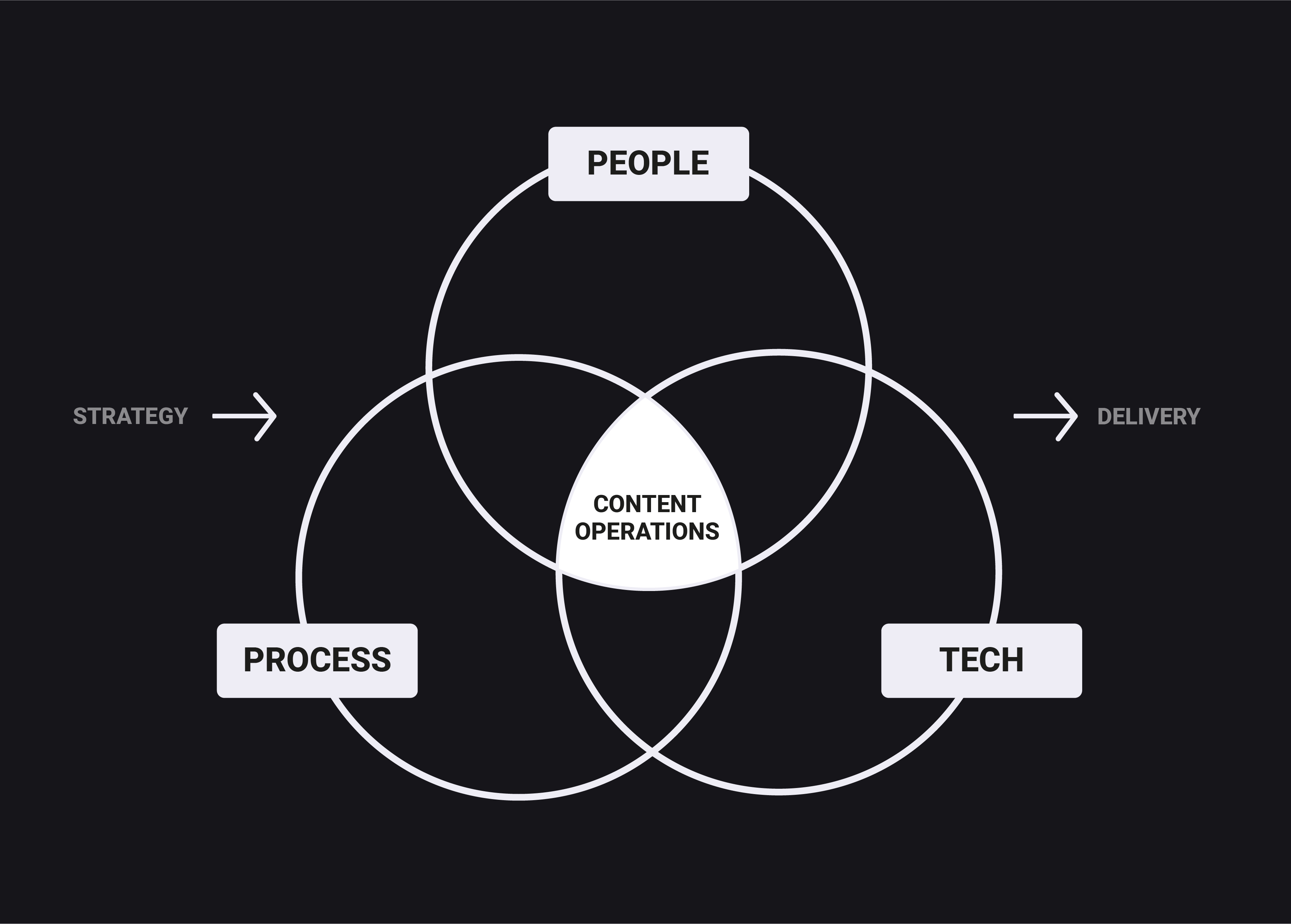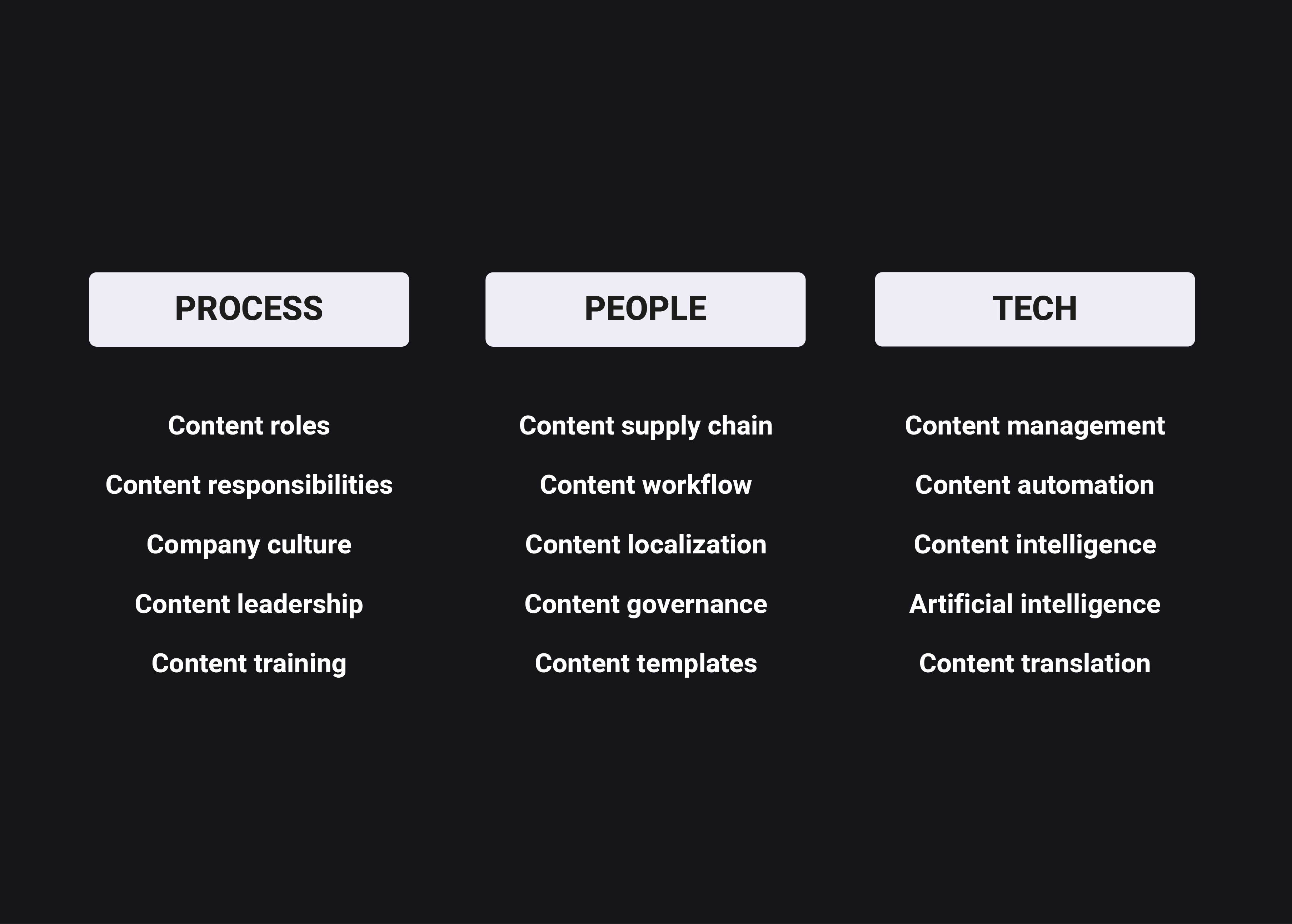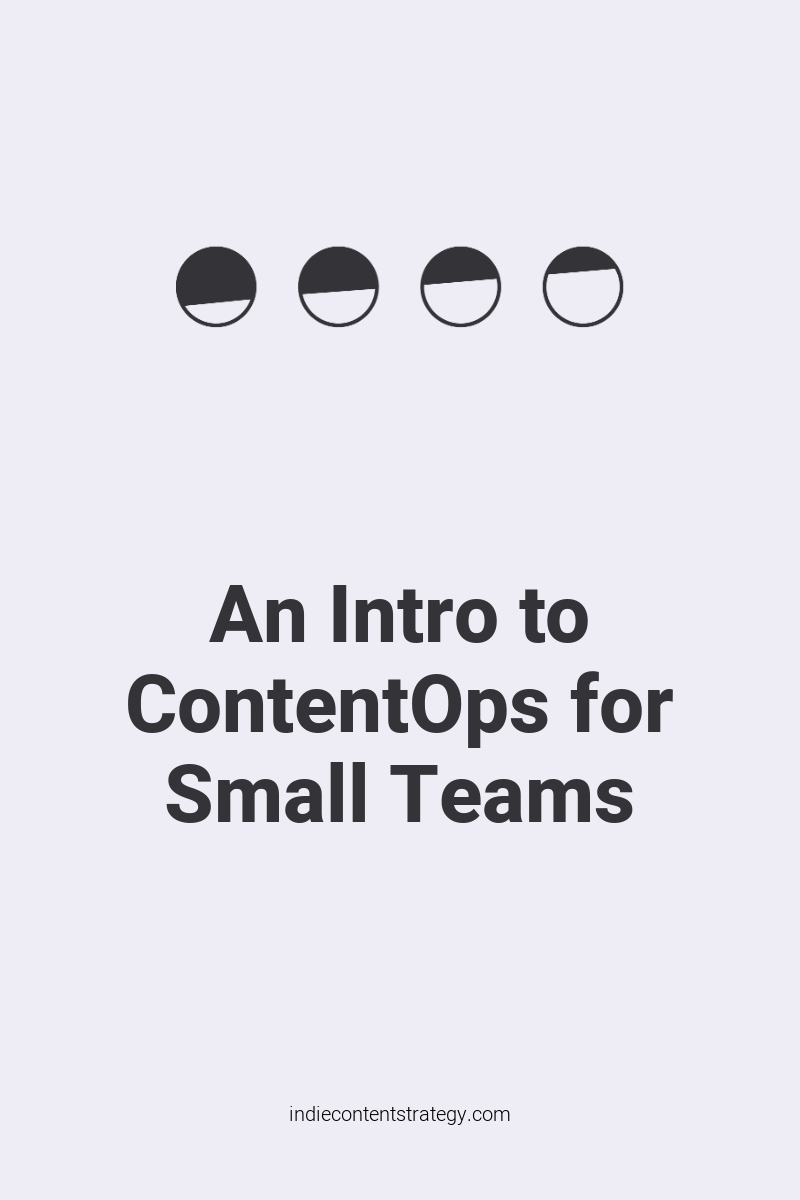You probably know the term DevOps: With DevOps, developers aim to do their jobs better with less friction by constantly improving how they do them. It’s a practice to optimize the efficiency and reliability of systems through automation and continuous delivery.
The same is true for ContentOps. We want to make working with content more efficient while keeping or even increasing its quality.
Scaling Content
If you have created content before, you know it’s more than writing a few words in an editor. For example writing a post for this blog consists of:
- Thinking „Hey, I should blog about this!“
- Researching and collecting resources in Pocket (or searching for sources I already visited but did not bookmark)
- Writing a draft in my notes app
- Asking for feedback and editing in the comments
- Transferring my text from my notes app to WordPress
- Formatting it
- Creating & adding images
- Adding metadata
I have to admit this process highly inefficient and chaotic. That may not be a huge problem for my small blog publishing 1-2 articles per month, but many companies that produce large amounts of content across departments share my approach, which is kind of scary.
Imagine the chaos if all the content on social accounts, newsletters, blogs, websites, landing pages, help centres, manuals, magazines and voice services is siloed, done by people who don’t talk to each other, written in different styles, containing different (outdated?) infos, duplicate,… Oh wait, maybe you don’t have to imagine that, because it’s like that in 99% of organizations I’ve seen so far. This is nothing unusual in grown structures, and you probably know the pain.
But there’s so much that can go wrong if we don’t have:
- Defined responsibilities, roles & processes
- Shared style guides and knowledge on how to do content
- Ways to measure success
- The technical basis to share assets and structure content
Most importantly, this does not scale at all.

(adapted from Content Operations – What is it and why should you invest in it? by GatherContent)
ContentOps aims at tweaking process, people and tech to make content scale.
It’s about creating repeatable systems that help to maintain quality while needing as little manual intervention as possible.
Copy-paste is not a system.
Rahel Bailie
It’s important to distinguish between a process (step 1 to 5) and a system (what’s used to go from step 1 to 5) at this point. Of course, processes are important, as they decide how effective you are. But a system decides how efficient you can be.
If we want to create a system that really helps us scale, we need to think beyond copy-pasting content from one app into another.
Scaling existing content, too
Just like DevOps is not only concerned with writing new code, ContentOps does not only focus on content creation. It also aims at optimizing analysis, planning, delivery & maintenance – basically all stages of the content lifecycle. (If you don’t know what I’m talking about, you can read up on the lifecycle model in my article Why bootstrapped content products suck)
Why ContentOps is important for small teams
ContentOps does sound especially valuable for big corporations, where content is lying around in silos and nobody talks to each other – and it is! But it’s highly valuable for small teams as well.
Most big corporations do not feel the cost of people doing duplicate, or inefficient work as much as small businesses: They can throw money at the problem for a longer time.
For small teams, freeing up resources for higher-level tasks can decide about the success or failure of their whole business. The less time your team needs to copy-paste content between systems, the more time they have to work strategically towards more revenue. This is especially important if people on the team wear multiple hats, and do not only work on content all day. So improving on ContentOps does not „only“ increase the ROI for content, but lets you run your whole (small) business more efficiently.
„Do things that don’t scale“ does not mean you should not strive to automate whatever makes sense. There’s a lot of busywork that you don’t have to do if you’re smart enough about it. Working on your Content Operations can make the difference between publishing 10 or 100 articles per month, or ranking place 20 or 1 on Google for your keywords, having accurate infos in your help centre or not, or having your content translated and ready for international clients instantly or not.
Fortunately, it’s a lot easier to improve Content Operations of a small business. Small teams can improve easily on people & processes, as there is less bureaucracy involved. They can move fast while staying connected to their mission and customers.
How to optimize ContentOps?
There are no standardized solutions for workflows and methods – and therefore no standardized solution for perfect content operations! Every business has to define their own principles and find technologies that support those.
In The Elements of Content Strategy, Erin Kissane qualifies the drafting of workflow recommendations as creative evaluation practice, which I found very accurate. We tend to think that processes and workflows are created from existent building blocks, but in fact, you design on a blank piece of paper every time. ContentOps is definitely an area where creative innovation has to happen to follow the goal of scale.
There are of course a few software products that can help you with ContentOps. GatherContent, for example, helps you by offering a unified platform to organise, plan and produce content in teams. Marketing automation tools like MailChimp help you to distribute that content afterwards. A scheduling tool like Buffer or Tailwind can put your Social Media on autopilot (especially with using their APIs). Most CMS can be adapted to provide services for ContentOps.
But in the end, it’s your job to dream up and create a system that fit your goals. Depending on your business, you might want to tweak different parts of ContentOps – people, process or tech.

(adapted from The Content Advantage by Colleen Jones, p. 162)
Examples of a 2-person team
I’m part of a team of two. We’re creating tech products like SaaS or online communities. As we’re both thinking quite technical, we focus a lot on automating things and creating software solutions and tools that make our operations leaner:
- Automation of Social Share Images: We automated the creation of Open Graph images, Twitter Card Images and Pinterest images for the websites we run. (We even turned this service into a separate product – placid.app.)
- Review Queue: We built a queue that tells us which content on our sites we should (probably) check and update next according to a list of influencing factors. It calculates „content health“ to help us monitor how much % of our content is (probably) still accurate.
- Content Scraper: When adding new projects to our collections on madewithvuejs.com, madewithlaravel.com or madewithreactjs.com, we just have to enter its URL to automatically scrape most of the info that we need for our description from that website. (For us that’s the project’s title, GitHub repo, Twitter Handles,..)
- Automated Twitter Queue: Automatic tweets are triggered by people starting a livestream on shipstreams.com.
You see these solutions are highly customized for the type of business(es) we run and the type of team we are.
Iterative Improvement
Improving on Content Operations is not a one-time project. I feel like this is a crucial point we are neglecting when talking about ContentOps at the moment. It sounds intimidating to suddenly completely change how we do content, but this isn’t how things work anyway. Remember that DevOps is all about continuous delivery? Well, same here!
We need to continuously and iteratively improve on different parts of our operations. These little projects have to be manageable enough for the people on the team, and should not put everything on hold. Like an agile mindset for product development, this kind of thinking is a lot easier to achieve in a smaller team.
If you get into the mindset of constantly optimizing, you will start to discover more and more opportunities to improve. I promise that these initiatives will feel really rewarding – like real progress.
How good are my ContentOps?
You might have a gut feeling on how effective your content operations are at the moment. A quick test: Ask the people creating content in your company about the most frustrating parts of their work. If you’re asking yourself “This is how we do things?” afterwards, you know it’s time to work on it.
To assess your content operations a bit more strategically, Colleen Jones developed a model to describe 5 levels of maturity of ContentOps.
- Chaotic – No formal content operations, only ad hoc approaches
- Piloting – Trying content operations in certain areas, such as for a blog
- Scaling – Expanding formal content operations across business functions
- Sustaining – Solidifying and optimizing content operations across business functions
- Thriving – Sustaining while also innovating and seeing return on investment
On the first level (“Chaotic”), content is approached on an ad-hoc basis, and there are no defined processes or leadership roles. In a company at that level you might hear “We should write a new blog article, the last one has published two months ago. Who has time to do that?”.
Operations on level five (“Thriving”) are sustainable across all departments, while constantly looking for innovation like evaluating new technology options. Responsibilities are clearly defined, and all stakeholders have an understanding of content value. These companies have built up content as one of their core competencies, rather than seeing content as part of marketing or other departments. They will likely see a significant ROI on content.
Colleen Jones offers a quiz to assess the maturity level of your content operations if you’re curious. It is developed to evaluate bigger organizations and focusses on alignment within teams, digital transformation initiatives and the like. So maybe you want to grab her book The Content Advantage instead – I highly recommend it – and cherrypick the parts about small businesses.
How does ContentOps compare to Content Strategy?
Technically, ContentOps is something that happens after the overarching content strategy is defined and implemented. It’s all about the daily work with content.
So you first define a goal and make a plan – the content strategy – and then you improve on the tactics on how to reach your goal with ContentOps. But while doing that, you may spot some insufficiencies in your strategy, like an incomplete content model, and can fix it accordingly.
As analysing and improving ContentOps informs strategic decisions, I think we should see those two fields as highly interdependent. One can’t live up to its potential without the other.
In another post, I emphasized that I think strategy without execution is worth nothing: As long as the output of a strategy does not reach the audience, its value is purely theoretical.
Improving on ContentOps is – in my opinion – the most powerful way to make all your strategic thoughts count.
Read more
- The coming of age of ContentOps – A transcript of a talk by Rahel Bailie
- A content operations maturity model by Colleen Jones
- The Content Advantage by Colleen Jones
- The need for Content Operations by Deane Barker
- ContentOps Slack Community



